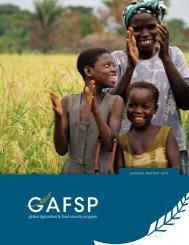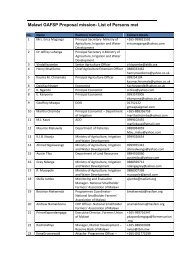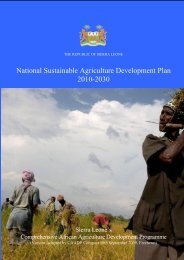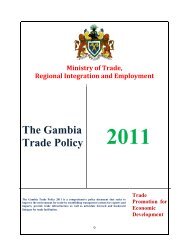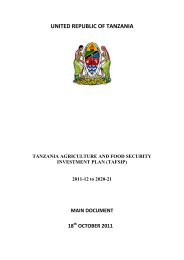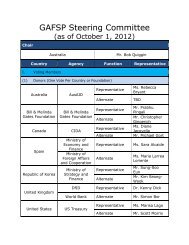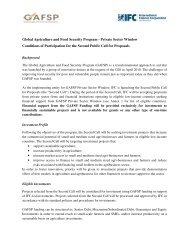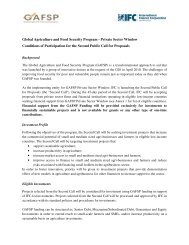- Page 1: © 2008 International Monetary Fund
- Page 5 and 6: Foreword by the Prime Minister Exec
- Page 7 and 8: LIST OF ABREVIATIONS ABD Budgetary
- Page 9 and 10: PRIME MINISTER'S FOREWORD The Growt
- Page 11 and 12: at both the local and national leve
- Page 13 and 14: of procedures for inspecting and as
- Page 15 and 16: central and local levels; (iii) mod
- Page 17 and 18: Description of the Process 6 This p
- Page 19 and 20: Institutional Framework National Le
- Page 21 and 22: CHAPTER 1 The Scope of Poverty and
- Page 23 and 24: CHAPTER 2 The Characteristics and D
- Page 25: Employment and Poverty 41 The open
- Page 29 and 30: CHAPTER 4 The Major Challenges to b
- Page 31 and 32: Table 6 GROWTH AND DEVELOPMENT REGI
- Page 33 and 34: Chapter 5 Pillar 1: Growth Vectors
- Page 35 and 36: PROMOTION OF FISHERIES AND AQUACULT
- Page 37 and 38: establishment of an institutional f
- Page 39 and 40: • Include in the partnership syst
- Page 41 and 42: lower, on the order of 35 percent.
- Page 43 and 44: PIP for 2006-2007 and scarcely 3.6
- Page 45 and 46: 114 Infant/child mortality has show
- Page 47 and 48: Objectives 121 The systems in place
- Page 49 and 50: Objectives 129 In this context, the
- Page 51 and 52: CHAPTER 7 Pillar 3: Democratic Gove
- Page 53 and 54: SECURITY • Launching of the EMA,
- Page 55 and 56: EXTENDING PNH COVERAGE TO THE ENTIR
- Page 57 and 58: Education, Social Affairs, Environm
- Page 59 and 60: etc.) to be able to bring something
- Page 61 and 62: 162 Peace and security mandate just
- Page 63 and 64: also an issue in rural areas, thoug
- Page 65 and 66: IX. MULTISECTORAL EFFORT TO COMBAT
- Page 67 and 68: Management Reform Program 189 This
- Page 69 and 70: Program for the Technological Moder
- Page 71 and 72: that project execution is monitored
- Page 73 and 74: exclusion and confrontation within
- Page 75 and 76: workers to encourage them to improv
- Page 77 and 78:
approximately 14 percent of GDP. Th
- Page 79 and 80:
strengthen the mechanisms for signa
- Page 81 and 82:
ii. The bulk of the additional reso
- Page 83 and 84:
CHAPTER 10 Strategy Financing, Impl
- Page 85 and 86:
2. MONITORING AND IMPLEMENTATION In
- Page 87:
performance indicators, and with pr
- Page 90 and 91:
CONTENTS 1. Schema of Overall Plann
- Page 92 and 93:
MATRIX OF OBJECTIVES/SUMMARY OF ACT
- Page 94 and 95:
2.- TOURISM OBJECTIVES 2007-2010 PA
- Page 96 and 97:
PILLAR 2: HUMAN DEVELOPMENT - PRIOR
- Page 98 and 99:
PILLAR 3: DEMOCRATIC GOVERNANCE - P
- Page 100 and 101:
TARGETED AND CROSS-CUTTING POLICIES
- Page 102 and 103:
5.- CULTURE AND COMMUNICATION OBJEC
- Page 104 and 105:
SUMMARY PILLAR 1: GROWTH VECTORS 78
- Page 106 and 107:
ECONOMIC ACCOUNTS TABLES
- Page 108 and 109:
Summary of Central Administration F
- Page 110 and 111:
Monetary Survey Projections (in mil
- Page 112 and 113:
PILLAR PILLAR 1: GROWTH VECTORS AGR
- Page 114 and 115:
SCHEMA OF INSTITUTIONAL FRAMEWORK F
- Page 116 and 117:
MONITORING INDICATORS TABLES
- Page 118 and 119:
Substantially rebuild the human cap
- Page 120 and 121:
Decentralization % of public expend
- Page 123 and 124:
HAITI. NATIONAL GROWTH AND POVERTY
- Page 125 and 126:
HAITI. NATIONAL GROWTH AND POVERTY
- Page 127 and 128:
HAITI. NATIONAL GROWTH AND POVERTY
- Page 129 and 130:
HAITI. NATIONAL GROWTH AND POVERTY
- Page 131 and 132:
HAITI. NATIONAL GROWTH AND POVERTY
- Page 133 and 134:
HAITI. NATIONAL GROWTH AND POVERTY
- Page 135 and 136:
HAITI. NATIONAL GROWTH AND POVERTY
- Page 137 and 138:
HAITI. NATIONAL GROWTH AND POVERTY
- Page 139 and 140:
HAITI. NATIONAL GROWTH AND POVERTY
- Page 141 and 142:
HAITI. NATIONAL GROWTH AND POVERTY
- Page 143 and 144:
HAITI. NATIONAL GROWTH AND POVERTY
- Page 145 and 146:
HAITI. NATIONAL GROWTH AND POVERTY
- Page 147 and 148:
HAITI. NATIONAL GROWTH AND POVERTY
- Page 149 and 150:
HAITI. NATIONAL GROWTH AND POVERTY
- Page 151 and 152:
HAITI. NATIONAL GROWTH AND POVERTY
- Page 153 and 154:
HAITI. NATIONAL GROWTH AND POVERTY
- Page 155 and 156:
MJSP HAITI. NATIONAL GROWTH AND POV
- Page 157 and 158:
HAITI. NATIONAL GROWTH AND POVERTY
- Page 159 and 160:
HAITI. NATIONAL GROWTH AND POVERTY
- Page 161 and 162:
HAITI. NATIONAL GROWTH AND POVERTY
- Page 163 and 164:
HAITI- NATIONAL GROWTH AND POVERTY
- Page 165 and 166:
HAITI- NATIONAL GROWTH AND POVERTY
- Page 167 and 168:
HAITI- NATIONAL GROWTH AND POVERTY
- Page 169 and 170:
HAITI- NATIONAL GROWTH AND POVERTY
- Page 171 and 172:
MCFDF MSPP MCFDF HAITI- NATIONAL GR
- Page 173 and 174:
HAITI- NATIONAL GROWTH AND POVERTY
- Page 175 and 176:
HAITI- NATIONAL GROWTH AND POVERTY
- Page 177 and 178:
HAITI- NATIONAL GROWTH AND POVERTY
- Page 179 and 180:
HAITI- NATIONAL GROWTH AND POVERTY
- Page 181 and 182:
HAITI- NATIONAL GROWTH AND POVERTY
- Page 183 and 184:
HAITI- NATIONAL GROWTH AND POVERTY
- Page 185 and 186:
HAITI- NATIONAL GROWTH AND POVERTY
- Page 187 and 188:
HAITI- NATIONAL GROWTH AND POVERTY
- Page 189 and 190:
HAITI- NATIONAL GROWTH AND POVERTY
- Page 191 and 192:
HAITI- NATIONAL GROWTH AND POVERTY
- Page 193 and 194:
HAITI- NATIONAL GROWTH AND POVERTY
- Page 195 and 196:
HAITI- NATIONAL GROWTH AND POVERTY
- Page 197 and 198:
HAITI- NATIONAL GROWTH AND POVERTY
- Page 199 and 200:
NATIONAL STRATEGY DOCUMENT FOR GROW
- Page 201 and 202:
NATIONAL STRATEGY DOCUMENT FOR GROW
- Page 203 and 204:
NATIONAL STRATEGY DOCUMENT FOR GROW
- Page 205 and 206:
NATIONAL STRATEGY DOCUMENT FOR GROW
- Page 207 and 208:
NATIONAL STRATEGY DOCUMENT FOR GROW
- Page 209 and 210:
D. DEBT AND CASH MANAGEMENT NATIONA
- Page 211 and 212:
NATIONAL STRATEGY DOCUMENT FOR GROW
- Page 213 and 214:
NATIONAL STRATEGY DOCUMENT FOR GROW
- Page 215 and 216:
NATIONAL STRATEGY DOCUMENT FOR GROW
- Page 217 and 218:
NATIONAL STRATEGY DOCUMENT FOR GROW
- Page 219 and 220:
NATIONAL STRATEGY DOCUMENT FOR GROW
- Page 221 and 222:
NATIONAL STRATEGY DOCUMENT FOR GROW
- Page 223 and 224:
Objective Actions 4. Gradually inte
- Page 225 and 226:
NATIONAL STRATEGY DOCUMENT FOR GROW
- Page 227 and 228:
NATIONAL STRATEGY DOCUMENT FOR GROW
- Page 229 and 230:
NATIONAL STRATEGY DOCUMENT FOR GROW
- Page 231 and 232:
NATIONAL STRATEGY DOCUMENT FOR GROW
- Page 233 and 234:
NATIONAL STRATEGY DOCUMENT FOR GROW
- Page 235 and 236:
OBJECTIVES 1. STRENGTHEN THE LINKAG
- Page 237 and 238:
NATIONAL STRATEGY DOCUMENT FOR GROW
- Page 239 and 240:
NATIONAL STRATEGY DOCUMENT FOR GROW
- Page 241 and 242:
NATIONAL STRATEGY DOCUMENT FOR GROW
- Page 243 and 244:
NATIONAL STRATEGY DOCUMENT FOR GROW
- Page 245 and 246:
NATIONAL STRATEGY DOCUMENT FOR GROW
- Page 247 and 248:
NATIONAL STRATEGY DOCUMENT FOR GROW
- Page 249 and 250:
NATIONAL STRATEGY DOCUMENT FOR GROW
- Page 251 and 252:
NATIONAL STRATEGY DOCUMENT FOR GROW
- Page 253 and 254:
NATIONAL STRATEGY DOCUMENT FOR GROW
- Page 255 and 256:
NATIONAL STRATEGY DOCUMENT FOR GROW
- Page 257 and 258:
NATIONAL STRATEGY DOCUMENT FOR GROW
- Page 259 and 260:
NATIONAL STRATEGY DOCUMENT FOR GROW
- Page 261 and 262:
NATIONAL STRATEGY DOCUMENT FOR GROW
- Page 263 and 264:
NATIONAL STRATEGY DOCUMENT FOR GROW
- Page 265 and 266:
NATIONAL STRATEGY DOCUMENT FOR GROW
- Page 267 and 268:
NATIONAL STRATEGY DOCUMENT FOR GROW
- Page 269 and 270:
OBJECTIVES 3.- IMPROVE THE TRANSPAR
- Page 271 and 272:
OBJECTIVES 5.- EVALUATE THE IMPACT
- Page 273 and 274:
NATIONAL STRATEGY DOCUMENT FOR GROW
- Page 275 and 276:
NATIONAL STRATEGY DOCUMENT FOR GROW
- Page 277:
NATIONAL STRATEGY DOCUMENT FOR GROW




